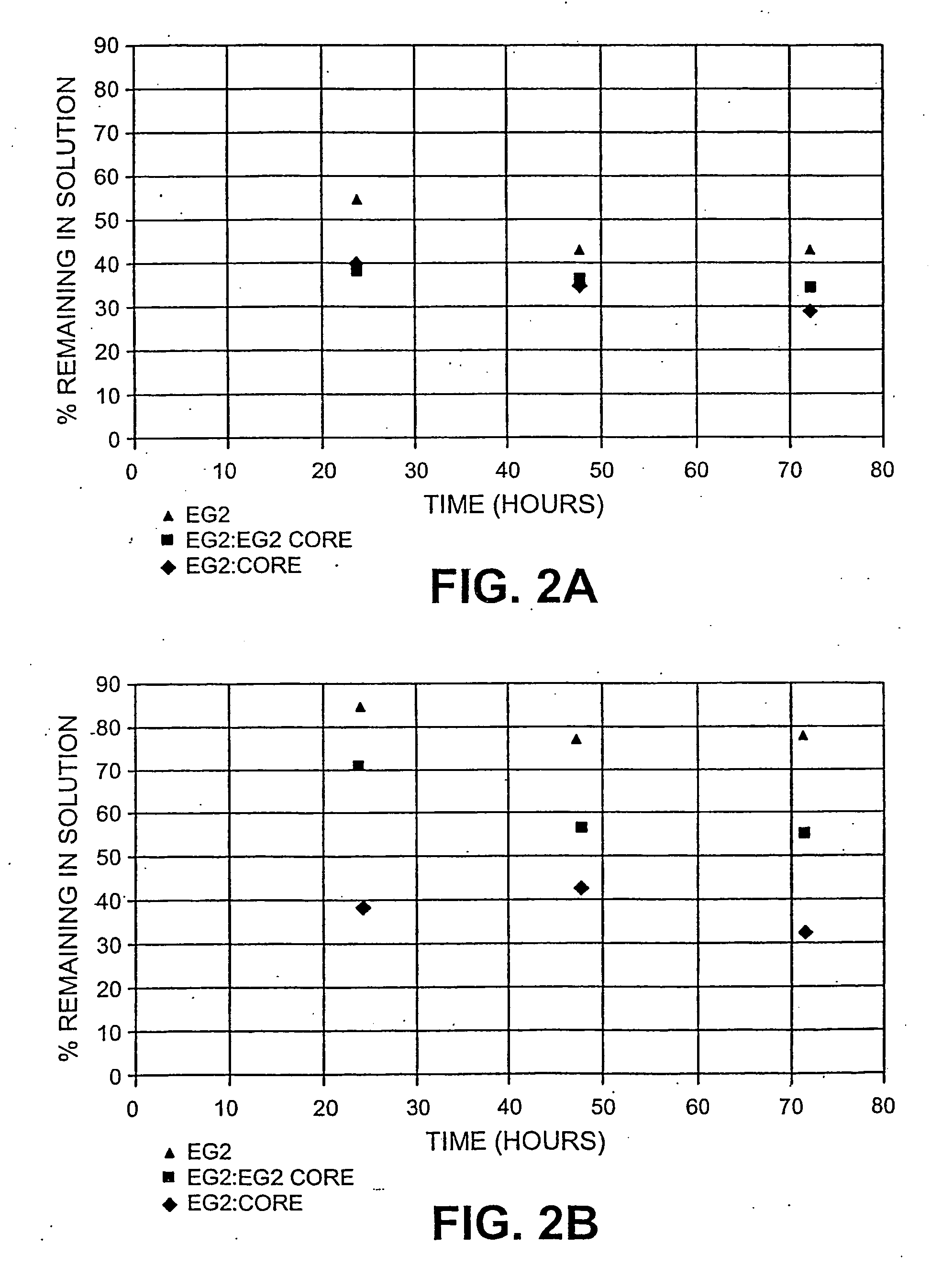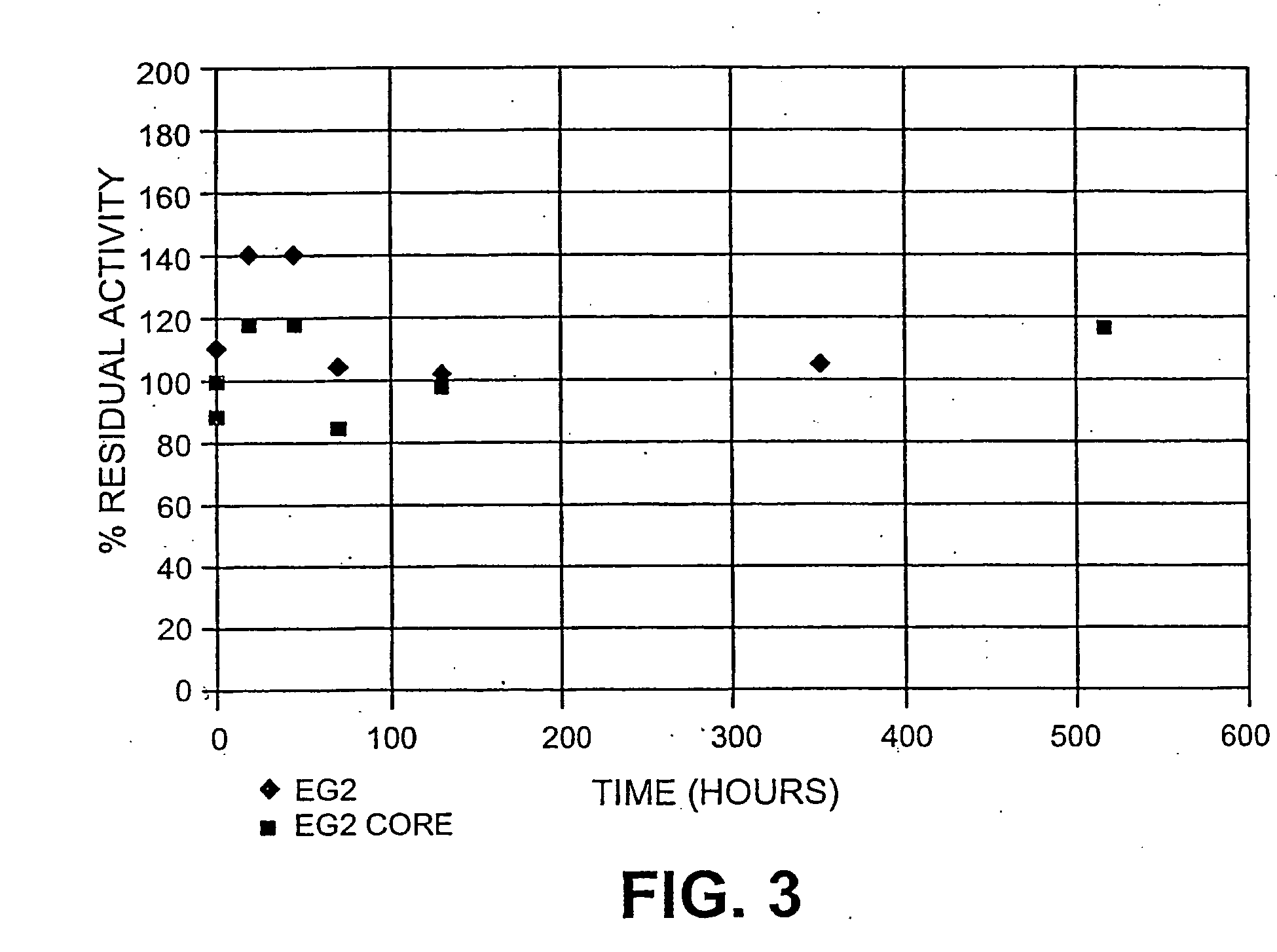Method for glucose production using endoglucanase core protein for improved recovery and reuse of enzyme
a technology of endoglucanase and endoglucanase, which is applied in the direction of biofuels, biochemical equipment and processes, enzymes, etc., can solve the problems of inability to easily degrade or depolymerize the beta 1,4 linkage which connects individual glucose units, poor extent of cellulose conversion using eg2 or eg2core alone, and inability to readily convert cellulose contained in most plant matter to glucos
- Summary
- Abstract
- Description
- Claims
- Application Information
AI Technical Summary
Problems solved by technology
Method used
Image
Examples
example 1
Hydrolysis of Enzymes Mixtures with Varying Levels of EG Core
[0075] The substrate used is whole oats as per U.S. Pat. No. 4,461,648; pretreatment process involved adding sulphuric acid from about 0 to 5% to the whole oats and the acidified mixture cooked for about 5 seconds to about 2 minutes, at a temperature of about 180 to about 250° C. The cellulose content of the pretreated material is 50%.
[0076] Purified CBH1 and CBH2 was obtained from a crude Trichoderma cellulase broth by first filtering the broth through glass microfiber filter paper. The cellulase liquid was then dialyzed using a 10,000 MW cut off membrane in order to lower its conductivity to 12,000 μS. The CBH1 was enriched by loading 190 mg protein / mL of resin onto pH 6 DEAE Sepharose ion exchange resin. The other components were desorbed from the resin before CBH1, by running 50 mM phosphate, 25 NaCl buffer at a conductivity of 9,000 μS throught the column. The CBH1 was desorbed by running 50 mM phosphate, 300 mM NaC...
example 2
Recovery of Protein from Solution Following Hydrolysis
[0084] As described above three separate 5% cellulose hydrolysis reactions in 50 mM pH 4.8 citrate buffer containing EG2, EG2:EG2core (in 50 wt % ratio) and EG2core were prepared. After a 24, 48 and 72 hours of incubation at 50 C the reaction mixtures were filtered to remove remaining solids, and amount of protein remaining in solution from the reaction was measured.
[0085] Protein measurement was done using a Biorad protein assay using a commercial product Iogen Cellulase (90 g / L) as a standard. The results are shown in Table 3. The two substrates analyzed were oats hulls and Sigmacell™.
TABLE 3Protein remaining in solution following hydrolysis% Recovery of ProteinSubstrate / Enzyme24 hrs48 hrs72 hrsOat HullsEG239.634.129.1EG2:EG2core37.436.037.4EG2core53.943.853.9SigmacellEG238.541.238.4EG2:EG2core70.956.070.9EG2core85.176.885.1
[0086] The amount of EG2core in solution throughout the course of hydrolysis is higher than the amoun...
example 3
Stability of EG2 and EG2 Core in Solution
[0088] The stability of purified EG2 and EG2core was assessed under the typical conditions of hydrolysis. The enzymes were incubated at a concentration of 2.4 mg / mL and 2.9 mg / mL respectively in a pH 4.8 citrate buffer at 50° C. Aliquots were removed and the level of Carboxymethylcellulose (CMC) hydrolysis was assessed by quantification of reducing sugars using DNS.
[0089] The results are shown in FIG. 3. Both EG2 and EG2core were found to be equally stable. Given that EG2core is equally stable and equally active in an cellulase enzyme mixture as described herein and also more recoverable than EG2 it offers the opportunity to be recovered and reused.
PUM
| Property | Measurement | Unit |
|---|---|---|
| Fraction | aaaaa | aaaaa |
| Fraction | aaaaa | aaaaa |
| Fraction | aaaaa | aaaaa |
Abstract
Description
Claims
Application Information
 Login to View More
Login to View More - R&D
- Intellectual Property
- Life Sciences
- Materials
- Tech Scout
- Unparalleled Data Quality
- Higher Quality Content
- 60% Fewer Hallucinations
Browse by: Latest US Patents, China's latest patents, Technical Efficacy Thesaurus, Application Domain, Technology Topic, Popular Technical Reports.
© 2025 PatSnap. All rights reserved.Legal|Privacy policy|Modern Slavery Act Transparency Statement|Sitemap|About US| Contact US: help@patsnap.com



